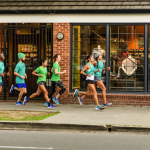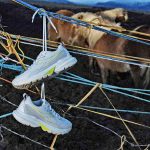Sales at chain stores were flat, up only 1.3% compared to last season. In dollars, that translates to $493.8 million in sales compared to $487.4 billion in 2003. Unit sales were up from last season 2.4%. Sales for the month of March in chain stores were $42.0 million compared to $48.3 million, a drop of 12.9%. Unit sales for the month of March were down 11.7% as compared to March 2003. “Chain stores benefited this season from a healthy increase in sales of snowboard apparel. By the end of the season, snowboard apparel sales had reached $39.1 million, an increase of 13% over last season,”said Christine Martinez, market research manager for SIA, the not-for-profit industry trade group that represents manufacturers and distributors of snow sports products.
Overall sales for the entire winter sport market (including specialty and chain stores), were flat — increasing slightly by 0.6 percent in dollars to $2.21 billion compared to $2.20 billion in 2003 for August through March according to the SnowSports Industries America (SIA) Retail Audit. Unit sales were ahead 3.5 percent.The SIA Retail Audit tracks and reports sales in all snow sports product categories. This is the final report of six that examines sales through March 31, 2004, the end of the winter season.
SNOWBOARD APPAREL SHOWS STEADY GROWTH
Apparel in chain stores did not perform as well as in the specialty stores this season. Milder weather in the West where chains reign, did not help apparel sales. Chain store apparel sales were flat, totaling $187.9 through March 2004.
However, snowboard apparel did manage to make some strong gains in chain stores this season, up 13% over last season to $39.1 million. Womens and junior snowboard tops did very well over last season, up 45% and 12%, respectively. This put snowboard top sales up 23% over last season. Snowboard bottoms also performed well, ending March 2004 with an 11% increase over last season.
Womens insulated parkas (up 7% to $14.8 million), womens shell parkas (up 33% to $8.8 million) and womens soft shell parkas (up 418% to $734,000) also helped to stabilize the apparel category this season. Also contributing to apparel sales were bibs, (up 275% to $3.0 million), soft shell waist pants (up 95% to $323,000), fleece (up 24% to $24.0 million) and apparel suits (up 15% to $2.6 million).
APPAREL ACCESSORY SALES UP FOR THE SEASON
The entire accessories category was up 7% in dollars to $158.7 million through March 2004. Apparel accessory sales performed very well, ending the season with $98.6 million in sales, a 13% increase over last season. As in specialty stores, winter boots were also hot in chains this season. Winter boots (up 84% to $6.1 million), turtlenecks (up 43% to $2.2 million), snowshoes (up 9% to $3.1 million), base layer (up 17% to $25.2 million), goggles (up 12% to $11.5 million), headwear (up 8% to $14.1 million) and gloves (up 5% to $20.0 million) all contributed to a gain in dollars over last season. As in the specialty stores, snow deck/skate and helmet sales were notably down this season, by 41% and 11%, respectively.
INTEGRATED SKI SYSTEMS SEE DOUBLE DIGIT GROWTH IN BOTH CHANNELS
Integrated ski systems showed positive signs this season in both chain and specialty stores. Integrated ski systems almost doubled their sales to $11.3 million this season with a tremendous 84% jump over last season. Average retail prices fell from $421 last season to $392 this season.
Overall equipment sales (alpine, snowboard, Nordic and telemark) were flat in dollars as compared to last season with sales totaling $147.3 million by the end of the season. Alpine equipment sales (including skis, boots, bindings, poles and systems) were up 3% over last season ending March 2004 with $71.7 million in sales.
Alpine skis, excluding integrated systems, fell 18% in dollars, as average retail prices fell 5% to $177. Substantial dollar decreases came from ski boards (down 58% to $490,000) and carryover skis (down 33% to $3.9 million). Midfat skis, accounting for 54% of all alpine ski sales (no systems), ended the season down 22% in dollars over last season.
There were some bright spots in the alpine ski category this season as chain stores diversified their offerings. Fat ski sales spiraled up 46% in dollars to $1.2 million through March 2004. Twintip ski sales rose 27% to $918,000. Their combined sales accounted for 10% of the alpine ski dollars sold. Carve ski sales increased 38% reaching $1.6 million in sales through March 2004. The average retail price of carve skis jumped from $146 to $211 comparing this season to last. Junior ski units jumped 27%, but lower average retail prices kept the dollar increase (9%) moderate.
Alpine boot sales fell 6% in dollars this season over last. A 27% unit drop in carryover boots helped the categorys average retail price increase from $158 last season to $169 this season. High performance boots were the only real performers, up 49% over last season to $8.5 million. The average retail price remained steady at $251 giving them 22% of the boot dollars sold this season. Dollar decreases came from recreation boots (down 49% to $3.2 million), carryover boots (down 28% to $3.6 million), soft boots (down 21% to $1.2 million) and junior boots (down 5% to $1.4 million). Sport performance boots, accounting for 31% of all boot dollars this season, increased 6% in dollars even as units slid 8%.
Stand-alone alpine binding sales fell 10% in dollars over last season totaling $9.1 million in sales through March 2004. DIN 8-11, which accounted for 59% of all bindings sold, declined 16% in dollars while the much smaller DIN 12-14 category grew 7% in dollars to $2.5 million. DIN 1-7 (down 58%), carryover (down 9%) and junior (down 3%) bindings all saw dollar decreases this season over last.
Alpine pole sales were flat over last season, up to $4.1 million in sales through March 2004. Adult poles (up 25% to $3.5 million) and junior poles (up 12% to $290,000) both saw sales increases over last season. However, a huge 70% drop in carryover pole sales held down growth for the entire alpine pole category.
COMBINED NORDIC AND TELEMARK SALES REACH $10 MILLION
Nordic skiequipment sales (including skis, boots, binding and poles) ended the season up 26% in dollars over last season, totaling $7.8 million in sales through March 2004. Nordic skis (up 24% to $3.1 million), boots (up 35% to $2.9 million) and bindings (up 25% to $1.0 million) all experienced substantial gains in dollar sales over last season.
Telemark ski eq uipment (including skis, boots and bindings) performed even better this season with a 45% jump in dollars over last season, ending March 2004 with $2.1 million in sales. At an average retail price of $234 in March 2004, telemark skis were up 32% over last season up to $761,000. Telemark boots (up 46%) and bindings (up 72%) also saw dollar increases over last season.
Combined Nordic and telemark sales totaled $9.9 million this season, compared to alpine equipments $71.7 million in sales.
FREESTYLE BOARDS SHINE
Snowboard equipment sales did not fare as well in chain stores as they did in specialty stores. Through March 2004, snowboard equipment sales were down 2% in dollars with total sales at $65.7 million.
Strong end-season snowboard sales helped turn early season negative numbers into a 3% dollar advantage over last season to $29.0 million. Boot (down 1% to $21.1 million) and binding (down 12% to $15.7 million) sales were both down this season over last. Hybrid and all mountain snowboards were down 33% and 23%, respectively, over last season.
Positive signs came from the 69% jump in sales of freestyle snowboards with an average retail price of $248 and ending the season with $5.5 million in sales. Carryover snowboards, which accounted for 39% of all snowboard units sold, were up 13% in dollar sales over last season.
Carryover boots (down 18% to $3.7 million) and bindings (down 27% to $2.3 million) did not fare as well as boards. Neither did step-in boots nor step-in bindings which both experienced substantial declines over last season, 72% and 79% drops, respectively.















